Marcus P. Corrosion mechanisms in theory and practice
Подождите немного. Документ загружается.

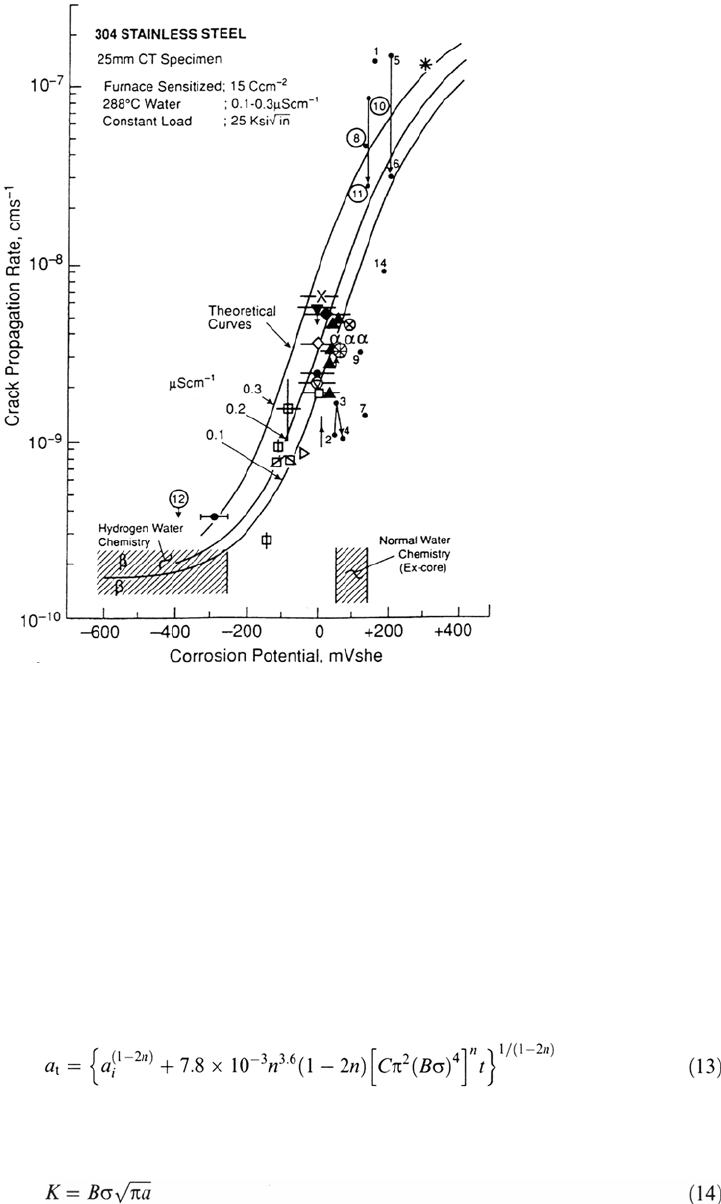
a predictable change in crack propagation rate of about a factor of 4. It follows,
therefore, that the practical use of such a prediction methodology for life predic-
tion, codification, etc. hinges on an adequate definition of the actual system via the
use of system monitors for corrosion potential, solution conductivity, etc. [2].
Integration of the crack propagation rate algorithms leads to an appropriate
crack depth—time (a – t) relationship, which, for a uniform tensile stress situation,
is of the form
624 Ford and Andresen
Figure 14 Observed and predicted relationships between the crack propagation rate and
corrosion potential for sensitized type 304 stainless steel in water under constant load. Water
conductivity in range 0.1 to 0.3 μS/cm. (From Ref. 1).
This particular form applies in the simple case in which the stress intensity can
be defined by
Copyright © 2002 Marcel Dekker, Inc.
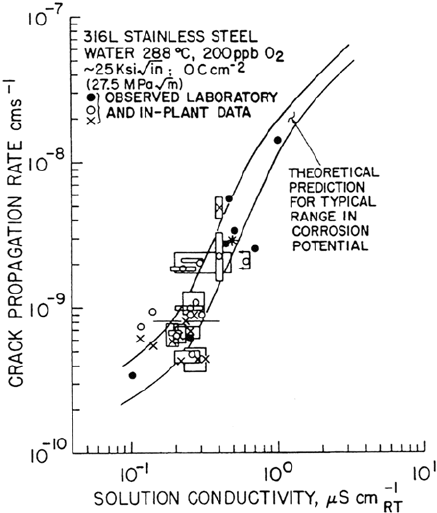
These formulations can become more complicated, e.g., for complex stress
fields adjacent to welds. Examination of Eq. (13) indicates that, at time zero, there
is an assumed intrinsic initiating defect, a
i
; in the following analyses for “smooth”
stainless steel components, a value of 50 μm has been used [2,10].
Equation (13), in conjunction with the variation in stress intensity as a crack
grows through a residual stress field adjacent to a weld, provides a prediction of the
effects of, e.g., (a) water purity on the crack depth–operating time for stainless steel
piping and (b) a range in residual stress on the predicted range of crack depths in a
piping system (Fig. 18). A range in actual system conditions inherently leads to a
predicted range in cracking response, as illustrated in Figure 19 for the theoretical
relationships between the coolant purity and the operating time required for a crack
to penetrate 25% of the wall thickness in a welded type 304 stainless steel pipe. These
theoretical relationships are shown for typical ranges in carbon contents (i.e., EPR
values) and in residual stress profiles. Figure 19 shows that the observed data
lie within the theoretical bounds. Thus, with this proven prediction capability,
quantitative decisions can be made about the future behavior for proposed
modifications in environment, material, or stress (Fig. 20).
Similar predictions can be made for the effect of irradiation on the
intergranular cracking susceptibility of stainless steel components in the reactor
core [114]. The prediction methodology developed for unirradiated conditions was
modified to account for the effect of fast neutron and gamma irradiation on (a)
Corrosion in Nuclear Systems 625
Figure 15 Observed and predicted relationships between the crack propagation rate and
solution conductivity for type 316L stainless steel under constant load (25 ksi √
—
in) in water
containing 200 ppm oxygen. (From Ref. 1).
Copyright © 2002 Marcel Dekker, Inc.

irradiation hardening and its effect on crack tip strain rates, (b) irradiation-induced
relaxation of residual stresses, (c) irradiation-induced depletion or enrichment of
compositional elements species at the grain boundary, and (d) the corrosion
potential via the radiolysis of water.
Once these individual effects have been qualified and verified, it is
relatively easy to extend the existing prediction methodology for IGSCC of
unirradiated stainless steels to cover the effects of fast neutron fluence on the
time to failure of stainless steels in oxygenated water (Fig. 21). Figure 22
shows the predicted variation of a “threshold” fluence (below which cracking is
not observed in, e.g., 10 operating years) for different combinations of stress and
626 Ford and Andresen
Figure 16 Comparison between observed and theoretical crack propagation rate–stress
intensity relationships for sensitized type 304 stainless steel in water at 288°C; 200 ppb
O
2
; 0.2 to 0.5 μS/cm.
Copyright © 2002 Marcel Dekker, Inc.

solution purity. Moreover, specific remedial actions can be defined to arrest
cracking which is detected in a reactor component. For example, Figure 23
shows the changes in corrosion potential necessary to arrest a crack in a BWR
core shroud.
Low-Alloy Steel/ BWR System
It is assumed that the slip dissolution model is applicable to transgranular
environmentally assisted cracking in the A533B/A508 low-alloy steel–water system at
288°C [1]. It is recognized that this assumption may introduce a systematic error due
Corrosion in Nuclear Systems 627
Figure 16 (Continued)
Copyright © 2002 Marcel Dekker, Inc.
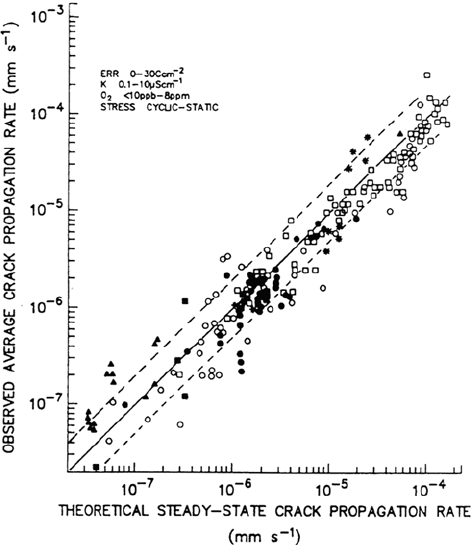
to undefined components of crack advance associated with film-induced cleavage or
hydrogen embrittlement, but this is regarded as a small error at this stage of the life
prediction methodology development [1,113]. Thus, Eq. (5) is retained as the primary
basis for prediction, and its quantification has been accomplished [1,79,113] in a
similar manner to that described for stainless steel. A primary difference, however,
has been the unique role played by the dissolution of MnS inclusions and the
associated definition of the crack tip environment [1,79,80]. This is addressed in
detail elsewhere [1,79,80,115–119], and it should merely be recognized that MnS
inclusions do dissolve in high-temperature water. The dissolution rate is sufficiently
rapid to increase the concentration of dissolved sulfur species in the crack and,
thereby, to increase the crack growth rate significantly. Other influential factors,
such as anion enhancement in the crack due to a gradient in potential down the
crack and anion deletion due to flushing of the crack at high bulk solution flow
rates, are also important, as in stainless steel.
The agreement between theory and observation of cracking under laboratory
conditions is encouraging [1,79], as in the agreement between the observed and
theoretical crack depth–operating time relationships for cracks in the limited number
of incidences of cracking in A508 feedwater nozzles of BWR reactors (Fig. 24). In
this latter case, cracks were observed to initiate on the surface due to thermal fatigue
628 Ford and Andresen
Figure 17 Relationship between the observed and theoretical steady-state propagation
rates for stainless steel in water at 288°C for a wide combination of material, stress, and
environment conditions. (From Ref. 1.)
Copyright © 2002 Marcel Dekker, Inc.
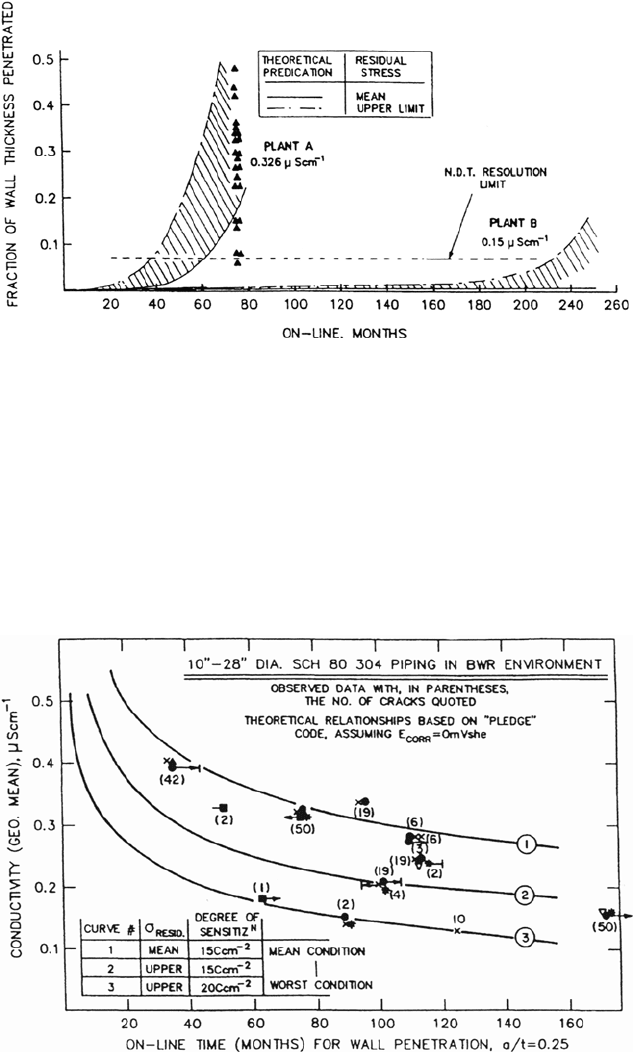
Corrosion in Nuclear Systems 629
Figure 18 Theoretical and observed crack depth vs. operational time relationships for
28-inch-diameter schedule 80 type 304 stainless steel piping for two BWRs operating
at different mean coolant conductivities. Note the bracketing of the maximum crack depth
in the lower-purity plant by the predicted curve that is based on the maximum residual stress
profile and the predicted absence of observable cracking in the higher-purity plant (in 240
operating months).
Figure 19 Observed and theoretical relationships between average BWR coolant
conductivity and the operational time to achieve quarter wall penetration. Observed data
from various operational BWRs are shown with the number of cracks detected shown in
parentheses beside each data point. Theoretical curves are for the quoted combinations of
stress and degree of sensitization at the HAZ.
Copyright © 2002 Marcel Dekker, Inc.

630 Ford and Andresen
Figure 20 Predicted response of defected piping for defined changes in water chemistry
in BWR plant.
Figure 21 Comparison between observed and theoretical relationships for the effect of
fast neutron fluence on the time to failure of irradiated type 304 stainless steel under constant
load in 32 ppm oxygenated water at 288°C.
Copyright © 2002 Marcel Dekker, Inc.
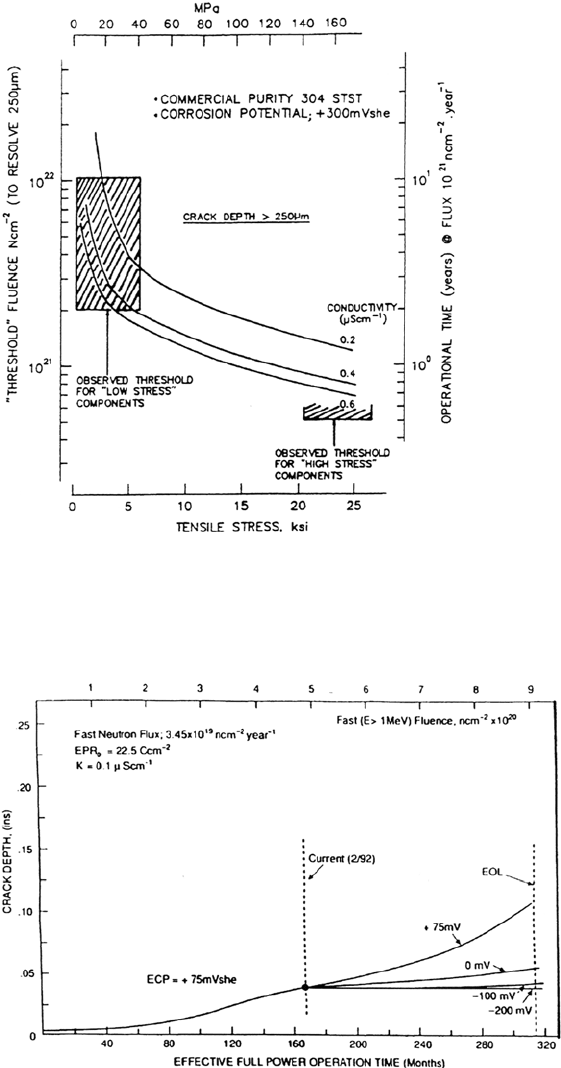
Corrosion in Nuclear Systems 631
Figure 22 Predicted and observed variations between threshold fluence for observation
of cracks in irradiated BWR components and the tensile stress and solution conductivity.
Figure 23 Predicted crack depth–time relationship for cracking in a hypothetical BWR
core shroud and the defined changes in corrosion potential required to slow down and
arrest the crack propagtion.
Copyright © 2002 Marcel Dekker, Inc.
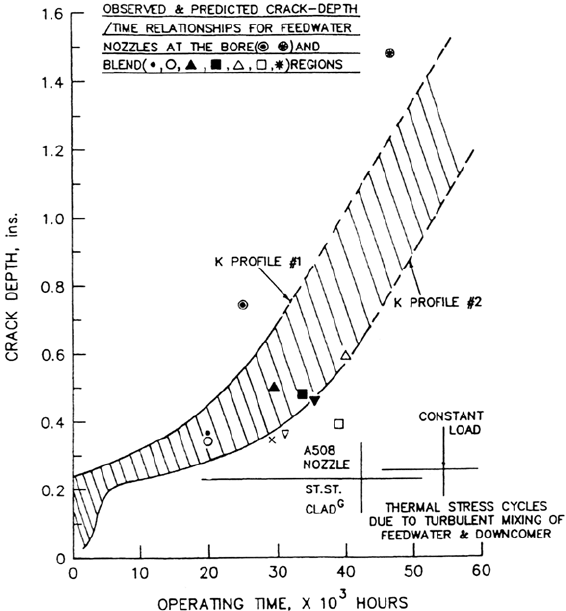
caused by mixing of hot water coolant and the cooler feedwater, and the theoretical
analysis [79] addressed the subsequent propagation of these cracks due to stress
corrosion from pressurization stresses alone.
As with stainless steels, the stress corrosion predictions can be logically
expanded to cover corrosion fatigue. Corrosion fatigue of low-alloy steels in LWR
environments and the impact on ASME XI life evaluation analyses have been
exhaustively reported [115–117]. In summary, the current ASME XI code for
corrosion fatigue crack propagation of low-alloy steels can be overly conservative
under certain operating conditions; however, under specific conditions of low
cyclic frequencies, high oxygen content environments, and high-sulfur steels, it is
predicted and observed that (da/dN)
ΔK
values greater than the ASME XI code
curve are possible [118].
The validity of the current ASME III code for corrosion fatigue crack initiation
in low-alloy and carbon steels in LWR environments is under current review [119].
Although the model development actions are still in a preliminary stage, it is
apparent that the cycles to crack initiation (N
i
) are predictable and that the conditions
under which the ASME III design curve is nonconservative can be defined (Fig. 25).
632 Ford and Andresen
Figure 24 Predicted and observed crack depth–operating time relationships in BWR
feedwater nozzles. (From Ref. 79.)
Copyright © 2002 Marcel Dekker, Inc.
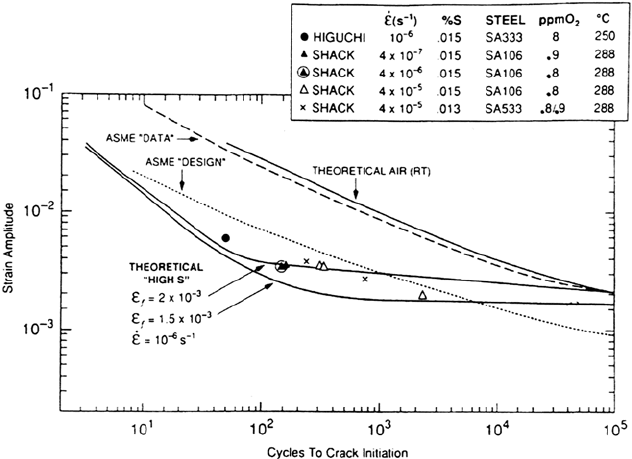
The laboratory and field experiences base for environmentally assisted
cracking low-alloy steel is far smaller than for sensitized stainless steel, and more
development and validation work is required before the prediction methodology
can responsibly be reduced to practice.
Nickel-Base Alloys/BWR System
The development of prediction models for environmentally assisted cracking of
nickel-base alloys in BWR systems is made difficult by the fact that the data base
against which the prediction models can be validated exhibits extreme scatter
(Fig. 26) and/or was obtained under conditions which are not directly applicable to
BWR operation (e.g., high conductivity). Establishing a link between crack growth
rates in stainless steels and ductile nickel-base alloys helps to resolve this problem,
since it permits the much broader base of data and modeling for stainless steels to
provide guidance on the expected response of nickel-base alloys in BWR systems
[70,120]. This mechanistic link is reasonable for the following reasons:
• Intergranular cracking is the dominant failure mode and is associated with
chromium depletion at the grain boundary in both types of alloys. For
stainless steels, EPR is used to quantify sensitization, as described above.
However, the EPR technique cannot be used without significant modification
Corrosion in Nuclear Systems 633
Figure 25 Predicted [119] and observed [121–123] strain amplitude vs. cycles to intiation
relationships for (unnotched) carbon and low-alloy steels in high-temperature water, under
the worst combination of material and environmental conditions. Note that carbon and
low-alloy steels behave very similarly, with a N
i
/Δ∈
t
response in high oxygen 250/288°C
water which is dictated by the high sulfur content of the steel.
Copyright © 2002 Marcel Dekker, Inc.
